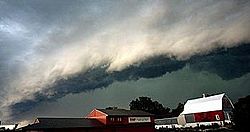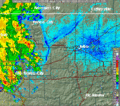Outflow (meteorology) facts for kids
Outflow is a term for the air that flows away from a thunderstorm. Lots of outflow show that a storm is "healthy".
The "edge" of the outflow boundary can often be detected by weather radar. Convergence occurs along the leading edge of the downdraft. Convergence of dust, aerosols, and bugs at the leading edge will lead to a higher clear air signature. The signature of the leading edge is also influenced by the density change between the cold air from the downdraft and the warm environmental air. This density boundary will increase the number of echo returns from the leading edge. Clouds, hydrometeors and new thunderstorms can also develop along the outflow's leading edge. This makes it possible to locate the outflow boundary when using precipitation mode. The image to the right depicts a particularly strong ouflow boundary ahead of a line of storms. Often, the outflow boundary will bow in the direction it is moving the quickest.
Images for kids
-
Radar image animation of an outflow boundary of a storm approaching Tulsa, Oklahoma. The outflow boundary's weak echo moves left-to-right and passes overhead of the Doppler radar station. The outflow produces a gust front that moves ahead of the main thunderstorm.
-
Structure of a tropical cyclone. The upper level outflow is depicted by cirrus clouds in the upper part of the schematic





